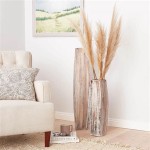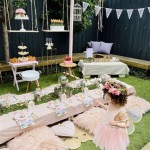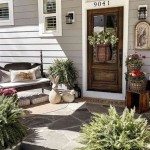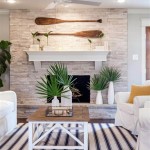```html
Interior Decoration: Definition and Scope
Interior decoration, often mistakenly used interchangeably with interior design, is the art and science of enhancing the aesthetic appeal of an interior space. It focuses primarily on the ornamentation and furnishing of a space to achieve a specific style, mood, or atmosphere. While interior design encompasses broader architectural and structural considerations, interior decoration deals almost exclusively with the surface treatments and the selection and arrangement of decorative elements.
The practice of interior decoration is deeply rooted in history, evolving in tandem with advancements in art, architecture, and cultural trends. Early forms of interior decoration can be traced back to ancient civilizations, where rudimentary forms of furniture, textiles, and wall paintings served both functional and decorative purposes. As societies progressed, so did the sophistication of interior decoration. The Renaissance, Baroque, and Victorian eras, among others, each contributed distinct styles and techniques, shaping the landscape of interior aesthetics.
The professional field of interior decoration emerged as a distinct discipline in the late 19th and early 20th centuries. The rise of mass production, coupled with increased consumerism, created a demand for individuals skilled in selecting and arranging furnishings and accessories. Early interior decorators often worked for wealthy clients, helping them create luxurious and opulent interiors. As the field matured, it became more accessible to a wider range of clients, catering to diverse tastes and budgets. Today, interior decoration is a thriving industry, encompassing a broad spectrum of styles, techniques, and technologies.
Key Elements of Interior Decoration
Interior decoration involves a multifaceted approach, integrating various elements to create a cohesive and visually appealing space. These elements can be broadly categorized into several key areas:
Color Palette: Color is arguably the most impactful element of interior decoration. It sets the tone and mood of a space, influencing perceptions and emotions. Interior decorators carefully consider the psychological effects of different colors, selecting a palette that aligns with the client's preferences and the intended use of the space. They may employ various color schemes, such as monochromatic, analogous, complementary, or triadic, to achieve a desired aesthetic effect. Furthermore, they consider the interplay of light and shadow on different colors, understanding how illumination affects the perceived intensity and vibrancy of the palette.
Furniture Selection and Arrangement: Furniture serves both functional and decorative purposes. Interior decorators meticulously select furniture pieces that complement the overall style of the space while meeting the practical needs of the occupants. They consider factors such as size, shape, material, and style to ensure that the furniture integrates seamlessly with the existing architecture and décor. The arrangement of furniture is equally crucial, as it affects the flow of movement, the sense of spaciousness, and the overall visual balance of the room. Interior decorators often employ principles of design, such as proportion, scale, and rhythm, to create harmonious and functional furniture layouts.
Textiles and Fabrics: Textiles and fabrics play a significant role in adding texture, warmth, and visual interest to a space. They are used in various applications, including upholstery, drapery, rugs, and cushions. Interior decorators carefully select fabrics that complement the color palette, style, and functionality of the space. They consider factors such as texture, pattern, durability, and maintenance when making their selections. The choice of fabrics can significantly impact the overall ambiance of the room, adding softness, richness, or a touch of elegance.
Lighting: Lighting is an essential element of interior decoration, affecting both the visual appeal and the functionality of a space. Interior decorators consider different types of lighting, including ambient, task, and accent lighting, to create a layered and well-illuminated environment. Ambient lighting provides overall illumination, while task lighting focuses on specific areas for activities such as reading or cooking. Accent lighting highlights particular features or objects, adding depth and visual interest. The selection of light fixtures is also crucial, as they contribute to the overall style and aesthetic of the room. Interior decorators may choose from a wide range of options, including chandeliers, pendant lights, sconces, and recessed lighting, to create the desired effect.
Accessories and Decorative Objects: Accessories and decorative objects are the finishing touches that personalize a space and reflect the client's individual style. These items can include artwork, sculptures, plants, mirrors, and decorative objects. Interior decorators carefully select accessories that complement the overall style and color palette of the room, adding character and visual interest. They consider the placement of accessories to create balanced and harmonious compositions. The use of personal collections and sentimental items can add a unique and personal touch to a space, making it feel more inviting and lived-in.
Distinguishing Interior Decoration from Interior Design
While the terms "interior decoration" and "interior design" are often used interchangeably, significant differences exist between the two disciplines. Interior design encompasses a broader range of responsibilities, including the planning and supervision of architectural modifications, space planning, and the selection of building materials. Interior decorators, on the other hand, focus primarily on the aesthetic aspects of a space, working within the existing architectural framework.
Interior designers are typically involved in the early stages of a project, collaborating with architects and contractors to create functional and aesthetically pleasing spaces. They may be responsible for designing floor plans, selecting building materials, and overseeing construction. Interior decorators come in later in the process, focusing on the selection and arrangement of furniture, textiles, accessories, and other decorative elements. Their primary goal is to enhance the aesthetic appeal of the space, creating a cohesive and visually harmonious environment.
In many jurisdictions, interior designers are required to be licensed or certified, demonstrating their competency in areas such as building codes, accessibility standards, and space planning. Interior decorators, however, are generally not subject to the same licensing requirements, as their work does not typically involve structural modifications or building code compliance. However, professional organizations offer certifications for Interior Decorators, demonstrating professional knowledge and standards.
The scope of work also differs significantly between the two disciplines. Interior designers may be involved in projects ranging from residential homes to commercial buildings, while interior decorators typically focus on residential or smaller commercial spaces. Interior designers may work on new construction projects, renovations, or remodels, while interior decorators primarily work on existing spaces. In essence, interior design is a more comprehensive and technical field, while interior decoration is more focused on the aesthetic aspects of a space.
Diverse Styles in Interior Decoration
Interior decoration encompasses a vast array of styles, each characterized by distinct design elements, color palettes, materials, and furnishings. These styles often reflect historical periods, cultural influences, or individual preferences. Some of the more common and influential styles include:
Traditional: Traditional interior decoration draws inspiration from historical periods, such as the Victorian era, the Georgian era, or the Renaissance. It is characterized by rich colors, ornate details, elegant furniture, and classic patterns. Traditional interiors often feature antique furniture, luxurious fabrics, and decorative accessories such as chandeliers, tapestries, and paintings. The overall ambiance is typically formal, elegant, and sophisticated.
Modern: Modern interior decoration emerged in the early 20th century, emphasizing simplicity, functionality, and clean lines. It is characterized by neutral color palettes, minimalist furniture, and the use of natural materials such as wood, glass, and metal. Modern interiors often feature open floor plans, large windows, and a focus on natural light. The overall ambiance is typically uncluttered, airy, and functional.
Contemporary: Contemporary interior decoration is a constantly evolving style that reflects current trends and innovations. It is characterized by a mix of modern and traditional elements, focusing on comfort, functionality, and style. Contemporary interiors often feature bold colors, geometric patterns, and a mix of textures. The overall ambiance is typically stylish, comfortable, and inviting.
Bohemian: Bohemian interior decoration is a free-spirited and eclectic style that celebrates individuality and creativity. It is characterized by vibrant colors, layered textiles, vintage furniture, and a mix of cultural influences. Bohemian interiors often feature plants, artwork, and personal collections. The overall ambiance is typically relaxed, comfortable, and artistic.
Minimalist: Minimalist interior decoration is a pared-down style that emphasizes simplicity, functionality, and the absence of clutter. It is characterized by neutral color palettes, minimal furniture, and a focus on essential items. Minimalist interiors often feature clean lines, open spaces, and a sense of calm and serenity. The overall ambiance is typically uncluttered, peaceful, and Zen-like.
Rustic: Rustic interior decoration draws inspiration from nature, emphasizing natural materials, earthy colors, and a sense of warmth and comfort. It is characterized by wood, stone, leather, and other natural elements. Rustic interiors often feature exposed beams, fireplaces, and handmade furniture. The overall ambiance is typically cozy, inviting, and nature-inspired.
These are just a few examples of the many styles that exist in interior decoration. Ultimately, the choice of style depends on the client's individual preferences and the desired ambiance of the space. Interior decorators work closely with their clients to understand their needs and preferences, translating them into a cohesive and visually appealing design.
```
Interior Architecture Wikipedia

Interior Design Wikipedia

Interior Design Simple English Wikipedia The Free Encyclopedia

Interior Design Home Wiki Fandom

Interior Portrait Wikipedia

Victorian Decorative Arts Wikipedia

Living Room Wikipedia

Drawing Room Wikipedia

Maison Jansen Wikipedia

Scandinavian Design Wikipedia
Related Posts







